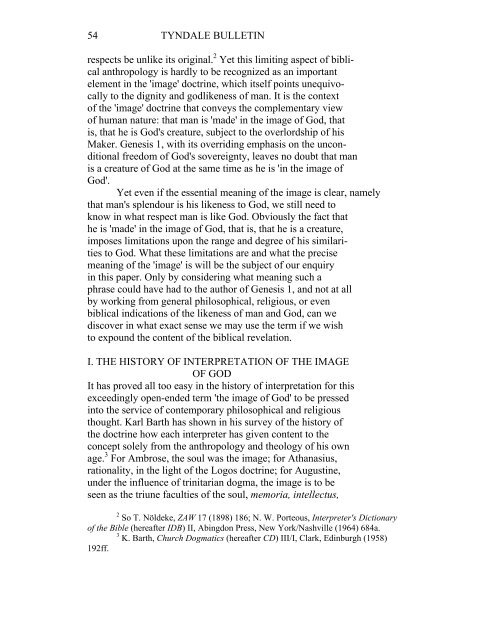THE IMAGE OF GOD IN MAN - Tyndale House
THE IMAGE OF GOD IN MAN - Tyndale House
THE IMAGE OF GOD IN MAN - Tyndale House
- TAGS
- tyndale
- tyndalehouse.com
You also want an ePaper? Increase the reach of your titles
YUMPU automatically turns print PDFs into web optimized ePapers that Google loves.
54 TYNDALE BULLET<strong>IN</strong><br />
respects be unlike its original. 2 Yet this limiting aspect of bibli-<br />
cal anthropology is hardly to be recognized as an important<br />
element in the 'image' doctrine, which itself points unequivo-<br />
cally to the dignity and godlikeness of man. It is the context<br />
of the 'image' doctrine that conveys the complementary view<br />
of human nature: that man is 'made' in the image of God, that<br />
is, that he is God's creature, subject to the overlordship of his<br />
Maker. Genesis 1, with its overriding emphasis on the uncon-<br />
ditional freedom of God's sovereignty, leaves no doubt that man<br />
is a creature of God at the same time as he is 'in the image of<br />
God'.<br />
Yet even if the essential meaning of the image is clear, namely<br />
that man's splendour is his likeness to God, we still need to<br />
know in what respect man is like God. Obviously the fact that<br />
he is 'made' in the image of God, that is, that he is a creature,<br />
imposes limitations upon the range and degree of his similari-<br />
ties to God. What these limitations are and what the precise<br />
meaning of the 'image' is will be the subject of our enquiry<br />
in this paper. Only by considering what meaning such a<br />
phrase could have had to the author of Genesis 1, and not at all<br />
by working from general philosophical, religious, or even<br />
biblical indications of the likeness of man and God, can we<br />
discover in what exact sense we may use the term if we wish<br />
to expound the content of the biblical revelation.<br />
I. <strong>THE</strong> HISTORY <strong>OF</strong> <strong>IN</strong>TERPRETATION <strong>OF</strong> <strong>THE</strong> <strong>IMAGE</strong><br />
<strong>OF</strong> <strong>GOD</strong><br />
It has proved all too easy in the history of interpretation for this<br />
exceedingly open-ended term 'the image of God' to be pressed<br />
into the service of contemporary philosophical and religious<br />
thought. Karl Barth has shown in his survey of the history of<br />
the doctrine how each interpreter has given content to the<br />
concept solely from the anthropology and theology of his own<br />
age. 3 For Ambrose, the soul was the image; for Athanasius,<br />
rationality, in the light of the Logos doctrine; for Augustine,<br />
under the influence of trinitarian dogma, the image is to be<br />
seen as the triune faculties of the soul, memoria, intellectus,<br />
2<br />
So T. Nöldeke, ZAW 17 (1898) 186; N. W. Porteous, Interpreter's Dictionary<br />
of the Bible (hereafter IDB) II, Abingdon Press, New York/Nashville (1964) 684a.<br />
3<br />
K. Barth, Church Dogmatics (hereafter CD) III/I, Clark, Edinburgh (1958)<br />
192ff.

















